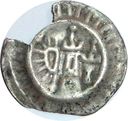Blaffert
Blaffert , also Blafferd, Upper German Plappart , Plappert or Blaphart, from French blafard "pale, bright", is the name of two different types of coins.
Southern Germany, Alsace, Switzerland
The Plappart was widespread as a groschencoin of the late Middle Ages, especially in Upper Germany. It had evolved around 1420 from the slightly inferior schilling . 20, 24 or 26 Plappert went for a Gulden , 9, 10, 12, 13, 15 or 17 Stäbler or 15, 16, 18, 19 or 22 Haller for a Plappert . The southern German Blaffert was stamped on both sides.
Probably it was first minted in Constance, later also in other Swabian cities (for example in Ulm 1429) and in Switzerland (from 1384/88 in Bern, 1417 in Zurich, 1424 in St. Gallen, 1425 in Basel). In Switzerland it was the largest silver coin until the introduction of the Dickens in 1482 and was replaced by the Batzen from the beginning of the 16th century . In Switzerland, however, the coin seems to have been in circulation until the 18th century.
Northern Germany
The Blaffert was a coin worth two pfennigs in northern Germany (documented: "penninghen from tween penninghen"). They were shaped by the cities of Lübeck, Hamburg and Lüneburg. The towns agreed on the appearance and weight of the Blafferte in recesses of the Wendish Mint Association . A distinction was made between two types. The first was designed on two sides and was minted in the 14th and 16th centuries. In its design it was a scaled-down version of the Witten, which was coined at the same time . The second was minted in the 15th century. Like the Hohlpfennige, it had a curved edge and was only embossed on one side, which is why this species is also called Hohlblaffert .
Lower Rhine, Middle Rhine
A coin table from Jülich-Berg shows that there was a Cologne silver coin in the Bergisches Land from the 18th century to 1824 that also bore this name. According to the City of Düsseldorf Policey and Tax Regulations of July 7, 1706, established by Duke Johann Wilhelm, 1 Reichstaler was equivalent to 8 Schilling or 60 Stüber or 20 Blaffert. In 1733, Blafferte were used as a means of payment in Linz am Rhein and were worth four wheels albus there . The author from Lüttringhausen also mentioned this term in Daniel Schürmann's "Practical textbook on general arithmetic and geometry" .
On December 1, 1738 was by Imperial Commission decree of Emperor Charles VI. In connection with the recognition of the Leipziger Münzfußes as the new Reichsmünzfuß, the Lower Rhine Blaffert was mentioned as a permitted piece of taler in the Reich and, as a Doppelblaffert, was a Kurant coin worth 9 Kreuzers. Furthermore, the following regional coins for the Lower Rhine region were listed in the commission decree: 4½ Kreuzer = 1 Blaffert, 2¼ Kreuzer = half Blaffert, 1½ Kreuzer = 1 Stüber, Cöllnischer Albus = quarter blimp, half Stüber = ¾ Kreuzer.
Starting from Northern Germany, under Archbishop Erik Valkendorf (1510–1522) in Nidaros (today's Trondheim ) one-sided minted blafferte worth 2 pfennigs or 1 ⁄ 6 Norwegian shillings were struck. Copper blafferte embossed on both sides were issued in Denmark from 1602 onwards.
literature
- Daniel Schmutz: Plappart. In: Historical Lexicon of Switzerland .
- Baden dictionary , vol. II p. 245, article Plappert .
- German Legal Dictionary , Vol. II Sp. 358, Article Blaffer (t) .
- Swabian Dictionary , Vol. I, Sp. 1155 f., Article Plappert .
- Schweizerisches Idiotikon , Vol. V Sp. 128-134, article Plapper (t), including compositions .
- Norsk historisk leksikon , article Blaffert .
- OC Gaedechens: Hamburg coins and medals . Ed .: Association for Hamburg History. Hamburg 1854.
Individual evidence
- ↑ According to information in the Baden and Swabian dictionary and in the Swiss Idiotikon, s. v. as well as under Haller II and Stäbler; For more on the history of coins see the Idiotikon.
- ^ Bruno Krings according to: Landeshauptarchiv Koblenz, Dept. 162 No. 1235.
- ^ Johann Christoph Stößel: Attempt at a Chur-Saxon coin history. Chemnitz 1780, pp. 676, 802 ff.
